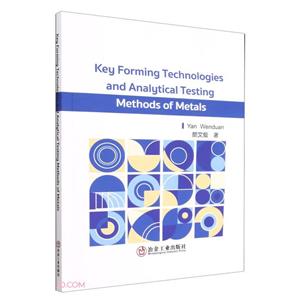-
>
湖南省志(1978-2002)?铁路志
-
>
公路车宝典(ZINN的公路车维修与保养秘籍)
-
>
晶体管电路设计(下)
-
>
无头案:雍正暴亡之谜
-
>
基于个性化设计策略的智能交通系统关键技术
-
>
花样百出:贵州少数民族图案填色
-
>
识木:全球220种木材图鉴
金属材料成形关键技术及分析测试方法 版权信息
- ISBN:9787502493578
- 条形码:9787502493578 ; 978-7-5024-9357-8
- 装帧:一般胶版纸
- 册数:暂无
- 重量:暂无
- 所属分类:>
金属材料成形关键技术及分析测试方法 内容简介
Engineering materials and related basic theories as well as frontier analysis techniques necessary for mechanical designers and manufacturers are described in this book. The book''''s content is carefully selected, covering basic knowledge of engineeringmaterials, key technologies of forming control of non-ferrous metal materials, advanced analysis, and testing research methods of non-ferrous metal are selected elaborately in the book. In particular, some traditional processing methods of metals, carefullychosen, and some advanced testing and analysis methods of materials and their development trends are also included. The book can be used as a textbook for graduate and undergraduate students majoring in mechanical engineering, and can also be read by workersand researchers engaged in mechanical processing.
金属材料成形关键技术及分析测试方法 目录
- >
有舍有得是人生
有舍有得是人生
¥19.4¥45.0 - >
推拿
推拿
¥12.2¥32.0 - >
月亮与六便士
月亮与六便士
¥13.4¥42.0 - >
中国人在乌苏里边疆区:历史与人类学概述
中国人在乌苏里边疆区:历史与人类学概述
¥40.8¥48.0 - >
山海经
山海经
¥22.6¥68.0 - >
名家带你读鲁迅:朝花夕拾
名家带你读鲁迅:朝花夕拾
¥14.3¥21.0 - >
唐代进士录
唐代进士录
¥26.7¥39.8 - >
我与地坛
我与地坛
¥16.8¥28.0
-
水泵运行原理与泵站管理
¥25.9¥37 -
机械设计手册 机器人与机器人装备
¥42.2¥48 -
日本图解机械工学入门系列日本图解机械工学入门系列--从零开始学机械设计
¥47.2¥59.8 -
从零开始学机械-学习机械技术.培养创新创造能力
¥23.5¥29.8 -
常用紧固件袖珍手册
¥13.3¥53 -
机械设计手册-第2卷-第六版
¥119¥170



















